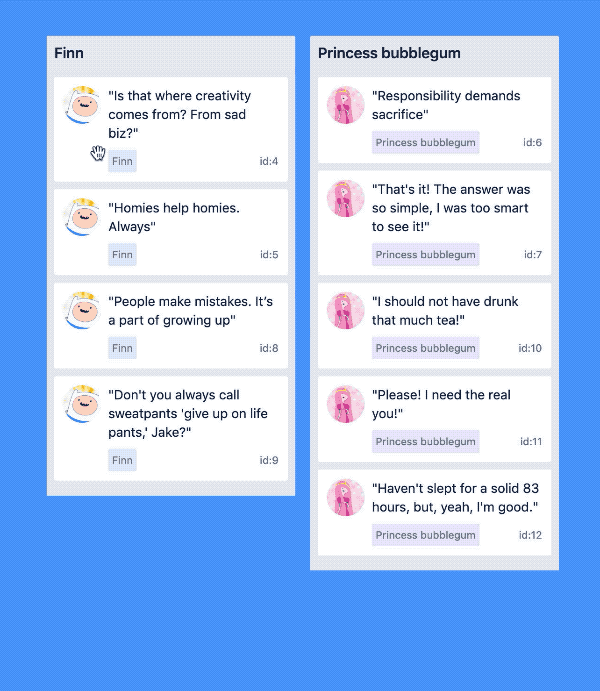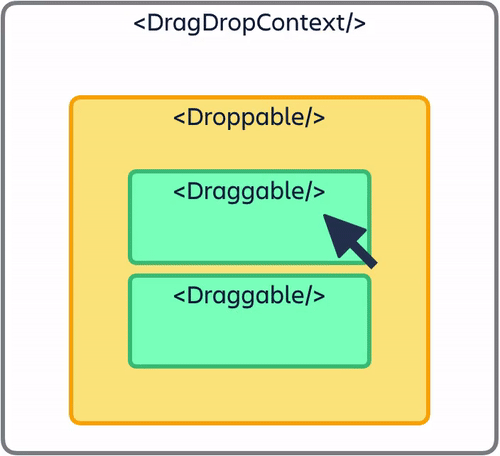Complexity and Use Case
- react-beautiful-dnd:
react-beautiful-dnd is designed for complex drag-and-drop interfaces, supporting nested lists and multiple draggable items. It provides a rich API that allows for advanced use cases, such as drag-and-drop between different lists, making it suitable for applications like Kanban boards. However, as it is deprecated, developers are encouraged to look for alternatives like
react-easy-sortorreact-sortable-hocfor ongoing projects. - react-sortable-hoc:
react-sortable-hoc offers a balance between simplicity and flexibility, allowing developers to create sortable lists and grids with ease. It is well-suited for applications that require custom drag-and-drop behavior without the complexity of a full-fledged solution.
- react-easy-sort:
react-easy-sort is focused on simplicity and ease of use, making it ideal for basic sortable lists. It is less feature-rich compared to others but excels in scenarios where minimal configuration and quick setup are required.
- react-sortable-tree:
react-sortable-tree specializes in tree structures, providing built-in support for hierarchical data manipulation. It is perfect for applications that need to visualize and manage nested data, such as file explorers or organizational charts.
Customization and Extensibility
- react-beautiful-dnd:
react-beautiful-dnd allows for extensive customization of drag-and-drop interactions, including animations and styling. It supports custom drag previews and drop effects, enabling developers to create a unique user experience tailored to their application's needs. However, as it is deprecated, developers should transition to supported libraries like
react-sortable-hocorreact-sortable-treefor future use. - react-sortable-hoc:
react-sortable-hoc provides a flexible API that allows for significant customization of the drag-and-drop experience. Developers can easily override default behaviors and styles, making it adaptable to various design requirements.
- react-easy-sort:
react-easy-sort is straightforward but offers limited customization options. It is best for developers who prioritize simplicity over extensive customization, making it less suitable for complex interfaces that require unique behaviors.
- react-sortable-tree:
react-sortable-tree offers customization options for tree nodes and drag-and-drop behaviors. Developers can define how nodes are rendered and how interactions are handled, making it suitable for applications with specific design needs.
Performance
- react-beautiful-dnd:
react-beautiful-dnd is optimized for performance, utilizing a virtualized rendering approach to minimize re-renders during drag-and-drop operations. This ensures a smooth user experience even with large lists or complex interactions. However, given that it is deprecated, developers should consider
react-sortable-hocorreact-sortable-treefor long-term performance optimizations. - react-sortable-hoc:
react-sortable-hoc is designed to handle performance efficiently, especially in sortable lists. It minimizes re-renders by only updating the necessary components during drag-and-drop actions, ensuring a responsive interface.
- react-easy-sort:
react-easy-sort is lightweight and performs well for basic use cases. However, it may not be suitable for applications with extensive data sets or complex interactions due to its simplicity and lack of advanced optimizations.
- react-sortable-tree:
react-sortable-tree is built to manage performance in tree structures, but it can become less efficient with very large trees. Developers may need to implement optimizations, such as virtualization, for better performance in extensive datasets.
Accessibility
- react-beautiful-dnd:
react-beautiful-dnd prioritizes accessibility by following WAI-ARIA standards, ensuring that drag-and-drop interactions are usable by all users, including those relying on assistive technologies. It provides keyboard navigation support and screen reader compatibility. However, as it is deprecated, developers should explore alternatives like
react-sortable-hocfor long-term accessibility support. - react-sortable-hoc:
react-sortable-hoc does not inherently focus on accessibility, so developers may need to implement additional features to ensure compliance with accessibility standards. It is suitable for applications where accessibility is a secondary consideration.
- react-easy-sort:
react-easy-sort has basic accessibility features but may not fully comply with WAI-ARIA standards. It is best for applications where accessibility is not a primary concern, given its simplicity.
- react-sortable-tree:
react-sortable-tree includes some accessibility features, but like react-sortable-hoc, it may require additional work to meet comprehensive accessibility standards. It is important for developers to consider accessibility when implementing tree structures.
Learning Curve
- react-beautiful-dnd:
react-beautiful-dnd has a moderate learning curve due to its comprehensive API and advanced features. Developers may need time to fully understand its capabilities and best practices for implementation. As it is deprecated, it is recommended to explore alternatives like
react-sortable-hocfor new projects. - react-sortable-hoc:
react-sortable-hoc has a moderate learning curve, offering a balance between ease of use and flexibility. Developers familiar with higher-order components in React will find it straightforward to integrate.
- react-easy-sort:
react-easy-sort is very easy to learn and implement, making it ideal for beginners or those looking for a quick solution to add sortable functionality without much overhead.
- react-sortable-tree:
react-sortable-tree may have a steeper learning curve due to its focus on tree structures and hierarchical data. Developers need to understand how to manage nested data effectively to utilize its full potential.






 한글/Korean
한글/Korean На русском/Russian
На русском/Russian Português/Portuguese
Português/Portuguese Ελληνικά/Greek
Ελληνικά/Greek 日本語/Japanese
日本語/Japanese